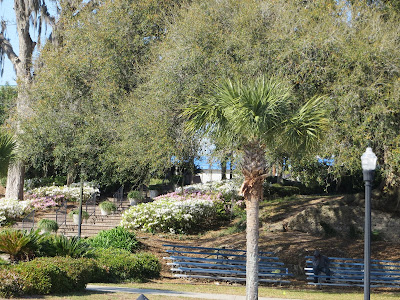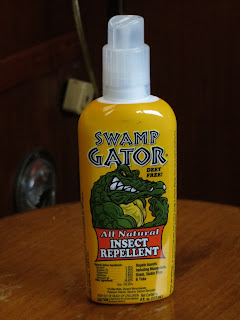We left Jekyll at dead low tide, bound for Brunswick to refuel. We had planned to spend a night at Brunswick but after 3 days at Jekyll, we need to cover some miles today. Refueling was quicker than we had expected at Ocean Petroleum. We still had about 150 gals but the price at Ocean was generally 40 cents/gal less than the next cheapest we could find and almost $1/gal less than the most expensive stops, so when you are buying hundreds of gallons, you buy as cheap as possible when you can. The docks were floating and very easily accessed, and "Big Shawn" had done this before. He was so nice and pleasant to talk with. He grew up in St. Marys and knew Nat (St. Marys post). He lived in Minneapolis for a while "but it was too cold." He's been at Ocean Petroleum for 7 years and is a chef at night with a new baby girl!
At low tide, we needed to pay attention today to charts, markers, caution areas, and navaids like range markers. For you non-boaters, range markers are placed at one end of a narrow channel. The closest marker is lower than the farthest one and you simply line them up to stay in the channel. They generally look like this. In this case below, we are slightly right of course correcting. When the white lines are lined up, you are in the center of the channel.
It gets a little tricky when you are going the opposite direction and the markers are behind you. Obviously you have to look out the back of the boat and steer thinking backwards I guess. I just do it and don't think much about how my brain is processing it and telling my arm/hand which way to steer.
And you gotta wonder why you can go for months and all daymarks are the same height well above the water and all of a sudden one is super low. ??????????????
The landscape changed a bit after passing Brunswick - the marshland added some treed areas that Rhonda really liked. Sort of like "tree islands" in the marsh.
Then we began to get some significant stretches of solid land occasionally.
And here's the Darien waterfront.
The shrimp boats are impressive and "The Blessing Of The Fleet" is next weekend.
A small city park is located at the docks and the azaleas were in bloom.
There are three "famous" oaks in town. This one is called "Tabby Oak" after the mixture of oyster shells, lime, sand, and water to make the "tabby" cement type mixture that was common in the early days and that comprises the wall underneath this oak.
The city is located on a bluff overlooking the river and marshland, the first of these we've seen in a while. One of the original historic buildings is for sale on the corner for 1.2 million.
The "Purple Pickle" is across the street and was recognized in Southern Living as a great food stop. We also ate at "Skippers" and then "B&J's" which was recommended by Big Shawn at Brunswick. All were outstanding.
Remember the paint brush tree in Sanford. Well, Darien has a glass bottle tree.
The distant view from town overlooking the marshland is beautiful.
Rhonda liked this shot of our "moustache" and a couple of Shrimp boats. Several had religious names like "Blessed Assurance."
We toured the city which had lots of parks and churches. I did not know until this trip that all Episcopal churches have red doors.
And then we were off to Fort King George.
This was a very unusual fort, very small compared to most and very different in shape, but pretty clever in design. You'll note that this fort is in great shape for a 1721 structure. That's because it is a replica, but built almost exactly as the original except for stairs versus ladders inside and some other minor changes.
The first line of defense was the long-range cannon row overlooking the river (which used to be the main waterway through here, and much larger before man made some changes in the water flow).
Then there was a moat and spiked poles.
Inside were three levels, the bottom was used for storage, sleeping quarters, cooking, etc.
The second floor had smaller cannon and slots in the wall for firing muskets.
I thought it was clever that the holes for firing were angled from the inside to provide a wider angle to shoot from inside but minimizing the size on the outside for "inbound" rounds.
The next floor up was really cool. In addition to more holes like the lower floor, this one also had holes in the floor to shoot through from the overhang to get the enemy that may have progressed to the lower outside of the fort. They were filled in of course for tourists walking through but you get the idea.
The general grounds consisted of barracks.
Cabins for the officers.
Storage areas.
A 4-holer outhouse which was "flushed" daily by the 2 tides of 6 to 7 feet.
The seats had "painted" holes only, I guess in case some tourists thought they were still operational.
A blacksmith area. Note the size of the bellows.
There were other areas for cattle, horses, etc.. About 200 soldiers died here. The tombstones were added later. The guide said the fort always buried the dead as inconspicuosly as possible and certainly without any fanfare or markers in case the enemy was watching. They did not want to portray any signs of weakness.
This area was also used for a major lumber yard and sawmill operation in its day. The mills were pretty clever. They would allow the high tides to fill large ponds with water, then use the outflow from the ponds to turn paddlewheels that would turn really large circular saw blades. There were no remnants of these mills except for a few brick and tabby foundations. The mills went out of operation after all the trees were cut down and others removed from the marsh and swampland.
Another tourist site in town is the old jail. Most of it is now an art gallery but one section still remains in its original state.
Here's an owl's home. Apparently they are common in this area.
We did not get out to see the old Butler rice plantation about a mile south of town. Storms rolled in and we actually ended up spending an extra day here waiting for all of that to clear up. If you are a traveling boater reading this blog, you should consider Darien, GA. The city offers free dockage and power for 48 hours and allowed us to stay the extra day for weather free of charge also. The town definitely makes you feel welcome.
And before we move on, I'm happy to report that Rhonda and I spent our 36th anniversary here. Congratulations to us!!!! Rhonda may be one of the most fortunate brides on the planet, her timing is impeccable. I was able to get her 300 gallons of diesel fuel for her birthday in October before we left Galveston. Then for Christmas she got 340 gallons in Stuart, Fl. Can you believe the timing was perfect for 310 gallons more for our anniversary? But since we (she) actually got that fuel the day before our anniversary, I really felt like something special was appropriate on the actual day of April 3rd.
Yep, Swamp Gator, guaranteed to keep the sand gnats away. Big Shawn told us about it when we refueled in Brunswick, said you could pick it up at any hardware store and sure enough, three blocks away, there it was right here in Darien. And it isn't oily or smelly like Skin So Soft and some of the others.
I managed to get some engine room work done today. Had to adjust the drip on the starboard shaft stuffing box and got the fluid changed for both transmissions. Leaving tomorrow for Kilkenny, GA, about 4 miles from the home we built at Belle Island. Memory lane again, looking forward to it.




































No comments:
Post a Comment